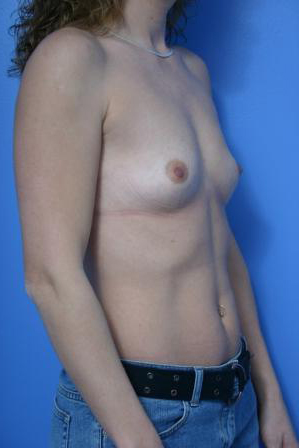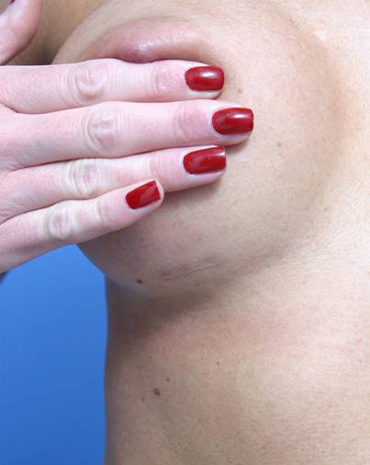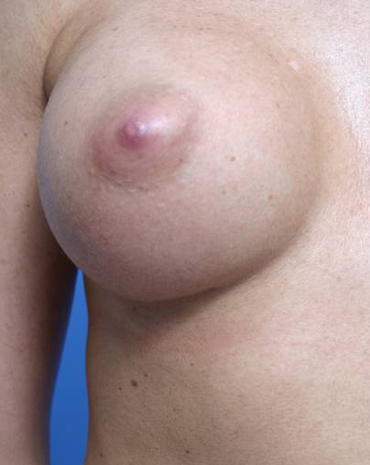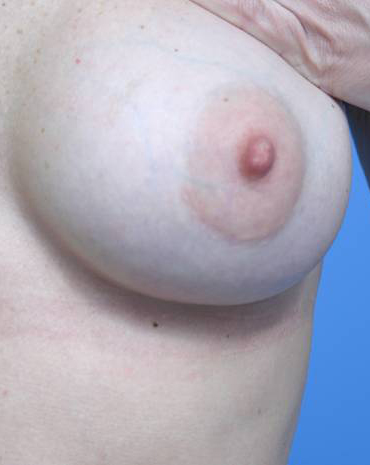
Breast Augmentation Before

Breast Augmentation After
Which incision should I use for breast augmentation?
The most common incision used for breast augmentation is the inframammary (under the breast) incision. Approximately 80% of women across the country have breast augmentation performed using this incision. It is usually well-hidden and has a low complication rate. The periareolar incision (scar around the colored part of the nipple) is another option. This incision typically heals well, but is located on the front of the breast. Studies are showing that the periareolar incision results in a higher risk of complications, such as capsular contracture. Therefore, Dr. Youn does not recommend this approach as the first option. The transaxillary (armpit) incision is also used, but primarily with saline implants and comes with a higher risk of capsular contracture as well. The belly button technique (trans-umbilical breast augmentation, or TUBA) is used by a handful of plastic surgeons nationwide, but conveys a higher risk of complications as well. Dr. Youn is not an advocate of the transumbilical or the transaxillary techniques and does not offer them.

Breast Augmentation Inframammary Scar

Breast Augmentation Inframammary Scar 2

Breast Augmentation Periareolar Scar
There are benefits and drawbacks with each of these implant types. Saline implants are simple, less expensive, and there is never a question of whether they are broken or not. These implants are filled with sterile salt water, the same fluid that is given to a person who is in the ER being treated for dehydration. If the implant outer shell develops a break or tear, the implant will quickly deflate, often within a couple hours. The saline that leaks out of the implant is safely absorbed by the body. Because it’s typically very obvious when a saline implant breaks, there is no need for expensive tests to follow these implants. The drawback of a saline implant is the fact that it is not as natural looking or feeling as a silicone implant. Some patients complain of wrinkles and ripples, mainly on the bottom or the sides of the implants.
A silicone implant looks and feels more natural than a saline implant but is more expensive and more controversial than saline. In general, the question is How Can We Tell If A Silicone Implant Is Broken? Because the silicone inside the new silicone implants is no longer a liquid, but a cohesive gel, it may be very difficult to tell whether an implant may have a break or tear in the outside shell. The FDA therefore recommends that all patients who undergo cosmetic breast augmentation with silicone implants undergo an MRI or ultrasound of the breasts 5 years after the original surgery and every other year thereafter. This is not a requirement, however. Make sure to discuss this with your board-certified plastic surgeon prior to undergoing a silicone gel breast augmentation.
The FDA has approved the shaped, form-stable silicone breast implants, otherwise known as the “gummy bear” breast implant. There are many differences between the gummy bear implant and the other silicone gel implants being used. First, the silicone gel inside the gummy bear implants is thick, firm, and resists deformation. For this reason, the implants are called “form-stable.” There is virtually no risk of silicone leakage with this implant. Second, the gummy bear implants are made in a teardrop shape with a textured (sandpaper-like) surface. Unlike the smooth, round silicone implants, these implants are not made to move around inside the breast pocket, but are designed to fit snug inside the breast. Third, the form-stable implant must be inserted through the scar under the breast, and utilizes a slightly longer scar than the other types of breast implants.
At this time, Dr. Youn no longer uses these implants. The textured shell of these implants comes with a risk of a very rare type of cancer called BIA-ALCL. Plastic surgeons are still learning more about this extremely uncommon condition, but to-date, all of the confirmed cases of BIA-ALCL have involved implants with a textured surface. For this reason, Dr. Youn only advocates smooth walled implants in his patients.
The Motiva breast implant from Establishment Labs is the newest silicone gel breast implant on the market. FDA approved in 2024, it’s been used around the world for the past 15 years, with over 4 million implants placed. The Motiva implant has an outer Smooth Silk surface, which is different from the traditional smooth and macro-textured surface implants that have been used for decades. This Smooth Silk surface feels very natural inside the body but also imparts a potentially lower risk of capsular contracture, which is the most common complication of breast implant surgery. In a consultation, Dr. Youn will be able to explain to you why the Motiva breast implant might be a good choice for your needs and desires.
Breast implants can be placed in a pocket either above the chest (pectoralis) muscle or below it. Traditionally implants were placed above the muscle. This allowed the implants to move with the rest of the breast tissue and provided for the shortest recovery. Unfortunately, there does appear to be a higher risk of capsular contracture (excessive scar tissue around the implant) with implants placed above the muscle. Because of this, many plastic surgeons now place the breast implants in a pocket below the pectoralis muscle. This creates a lower risk of capsular contracture and arguably allows better visualization on a mammogram.
Unfortunately, in certain patients with wide-spaced breasts it can result in a space between the breasts which some women don’t like, along with movement of the implants when the pectoralis muscle is flexed. It is also not ideal for patients whose breasts are a bit droopy. At your consultation, Dr. Youn will explain the various risks and benefits of each type of implant pocket, and determine with you which is your best approach.
Most patients will take a handful of pain pills and should take 1-2 weeks off of work. Exercise can resume after 3 weeks.
What is the Rapid Recovery Breast Augmentation?
The Rapid Recovery Breast Augmentation is a technique that Dr. Youn utilizes in many of his patients. By combining a reasonable implant size, a non-traumatic surgical technique, and avoidance of drains, Dr. Youn’s Rapid Recovery Breast Augmentation patients are able to be off narcotic pain pills and back to nearly normal activities within 24-48 hours. Dr. Youn revealed this technique with a patient on the Rachael Ray Show.
How Long Does the Surgery Take?
Breast augmentation takes between one to two hours, and is performed under general anesthesia as an outpatient. I would exercise caution if a plastic surgeon takes less than an hour to do your breast augmentation. Speed does not necessarily equate to quality, and in fact, may be just the opposite.
How can I determine which size implant is best for me?
There are many methods to determining what breast implant size to use. First of all, all breast implants are measured in cc’s or milliliters. There is no standard A, B, C, or D size implant. Because everyone’s bodies are different and their starting breast sizes are different, an implant that could make one person a C could make another person a B. For example, a 350 cc implant may make a person who is 5’4″, and 110 lbs a C cup, whereas it may make a person who is 5’9″ and 160 lbs a B cup.
One at home method for determining breast implant size includes the Rice Test -fill nylon stockings with a measured amount of rice and place it in a sheer bra.
Some plastic surgeons prefer the “Trust Me, I’ll Make You Look Good” approach. Dr. Youn does not do this, since people have different ideas of what size will make them happy and it doesn’t give the patient enough control over her outcome. The most common method of sizing patients for breast implants is to use preoperative sizers. These are premeasured silicone implants which are placed on top of the breast with a bra to simulate what size a person will be after surgery. Dr. Youn sometimes does this with patients during the initial consultation.

